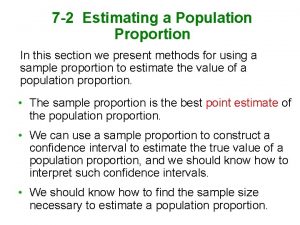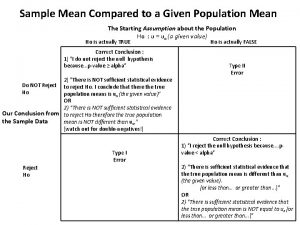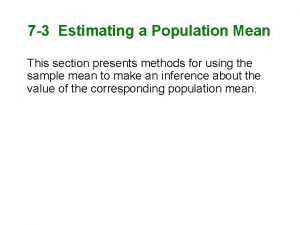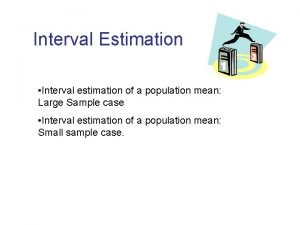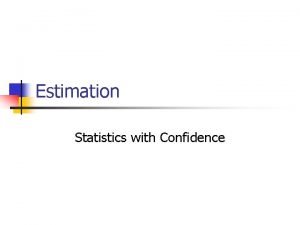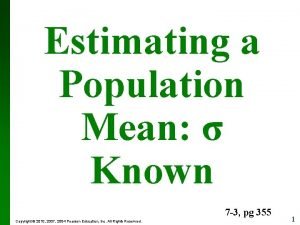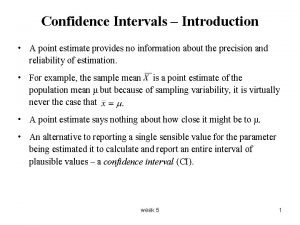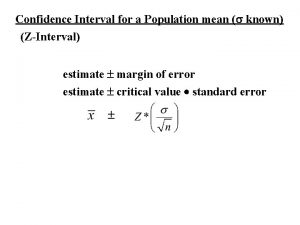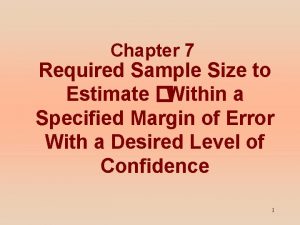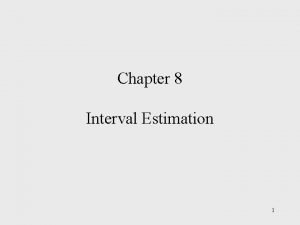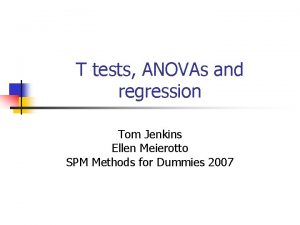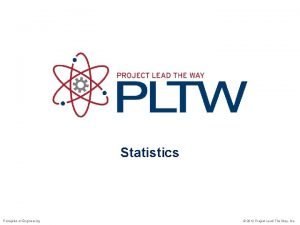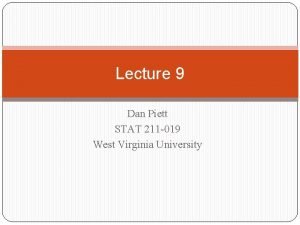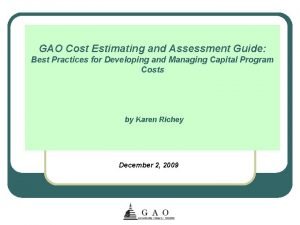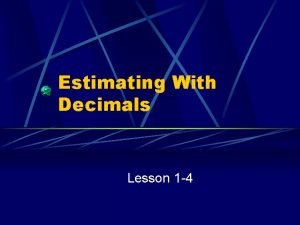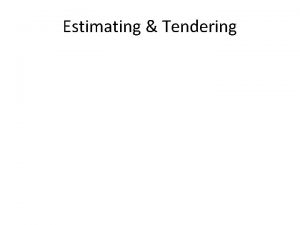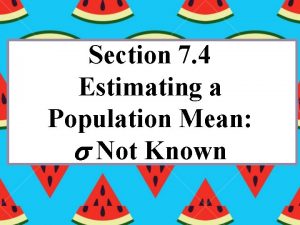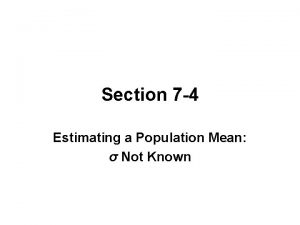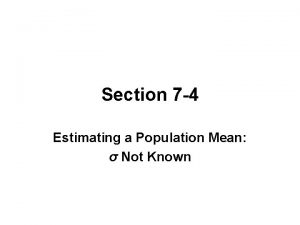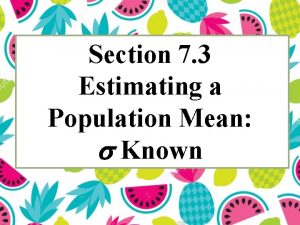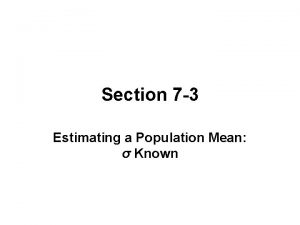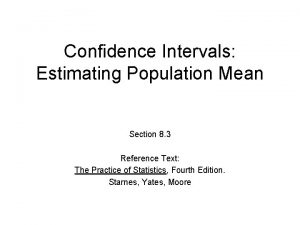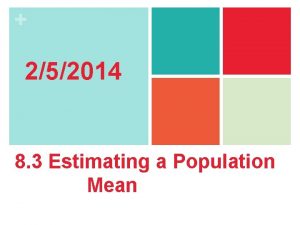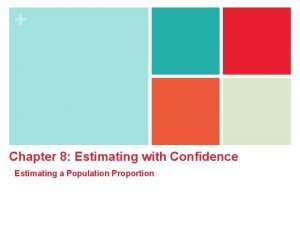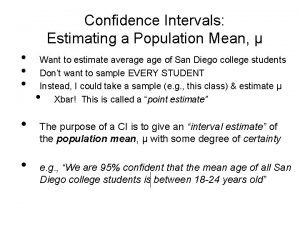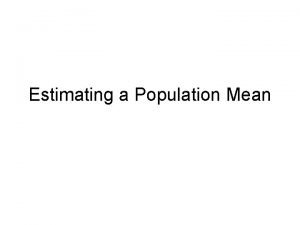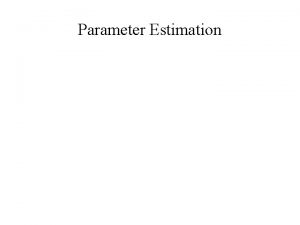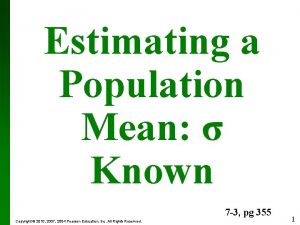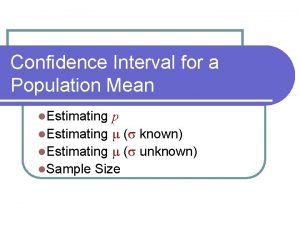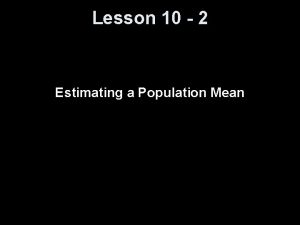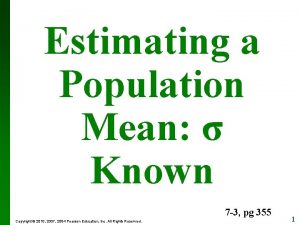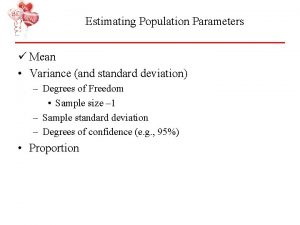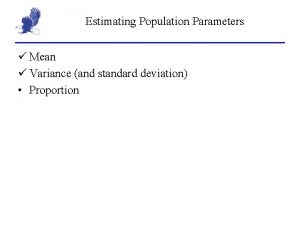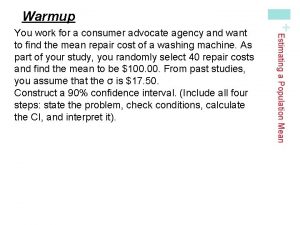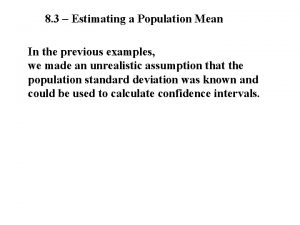Section 8 3 Estimating a Population Mean Section



























- Slides: 27

Section 8. 3 Estimating a Population Mean

Section 8. 3 Estimating a Population Mean After this section, you should be able to… ü CONSTRUCT and INTERPRET a confidence interval for a population mean ü DETERMINE the sample size required to obtain a level C confidence interval for a population mean with a specified margin of error ü DESCRIBE how the margin of error of a confidence interval changes with the sample size and the level of confidence C ü DETERMINE sample statistics from a confidence interval

Confidence Intervals: Conditions 1) Random: The data should come from a well-designed random sample or randomized experiment. 2) Normal: The sampling distribution of the statistic is approximately Normal. The sampling distribution is exactly Normal if the population distribution is Normal. When the population distribution is not Normal, then the central limit theorem tells us the sampling distribution will be approximately Normal if n is sufficiently large (n ≥ 30). 3) Independent: Individual observations are independent. When sampling without replacement, the sample size n should be no more than 10% of the population size N (the 10% condition).


Determining Minimum Sample Size The margin of error ME of the confidence interval for the population mean µ is: We determine a sample size for a desired margin of error when estimating a mean in much the same way we did when estimating a proportion.

Example: How Many Monkeys? Researchers would like to estimate the mean cholesterol level µ of a particular variety of monkey that is often used in laboratory experiments. They would like their estimate to be within 1 milligram per deciliter (mg/dl) of the true value of µ at a 95% confidence level. A previous study involving this variety of monkey suggests that the standard deviation of cholesterol level is about 5 mg/dl. ü The critical value for 95% confidence is z* = 1. 96. ü We will use σ = 5 as our best guess for the standard deviation.

Example: How Many Monkeys? Multiply both sides by square root n and divide both sides by 1. Square both sides. We round up to 97 monkeys to ensure the margin of error is no more than 1 mg/dl at 95% confidence.

When is Unknown: The t Distributions When we don’t know σ, we can estimate it using the sample standard deviation sx. What happens when we standardize? This new statistic does NOT have a Normal distribution!

When is Unknown: The t Distributions When we standardize based on the sample standard deviation sx, our statistic has a new distribution called a t distribution. It has a different shape than the standard Normal curve: ü It is symmetric with a single peak at 0, ü However, it has much more area in the tails.

The t Distributions: Degrees of Freedom When we perform inference about a population mean µ using a t distribution, the appropriate degrees of freedom are found by subtracting 1 from the sample size n, making df = n - 1. We will write the t distribution with n - 1 degrees of freedom as tn-1.

The t Distributions: Degrees of Freedom When comparing the density curves of the standard Normal distribution and t distributions, several facts are apparent: üThe density curves of the t distributions are similar in shape to the standard Normal curve. üThe spread of the t distributions is a bit greater than that of the standard Normal distribution. üThe t distributions have more probability in the tails and less in the center than does the standard Normal. üAs the degrees of freedom increase, the t density curve approaches the standard Normal curve ever more closely.

Using Table B to Find Critical t* Values Suppose you want to construct a 95% confidence interval for the mean µ of a Normal population based on an SRS of size n = 12. What critical t* should you use? Upper-tail probability p df . 05 . 02 . 01 10 1. 812 2. 228 2. 359 2. 764 11 1. 796 2. 201 2. 328 2. 718 12 1. 782 2. 179 2. 303 2. 681 z* 1. 645 1. 960 2. 054 2. 326 90% 95% 96% 98% Confidence level C In Table B, we consult the row corresponding to df = n – 1 = 11. We move across that row to the entry that is directly above 95% confidence level. The desired critical value is t * = 2. 201.

Critical Values Practice What critical value t* from Table B should be used for a confidence interval for the population mean in each of the following situations? Degrees of Freedom? (a) A 90% confidence interval based on n = 12 observations. (b) A 95% confidence interval from an SRS of 30 observations.

Critical Values Practice What critical value t* from Table B should be used for a confidence interval for the population mean in each of the following situations? Degrees of Freedom? (a) A 90% confidence interval based on n = 12 observations. df = 11, t*= 1. 796 (b) A 95% confidence interval from an SRS of 30 observations. df = 29, t*=2. 045


t Distribution: Normal Condition • Sample size less than 15: Use t procedures if the data appear close to Normal (roughly symmetric, single peak, no outliers). If the data are clearly skewed or if outliers are present, do not use t. • Sample size at least 15: The t procedures can be used except in the presence of outliers or strong skewness. • Large samples: The t procedures can be used even for clearly skewed distributions when the sample is large, roughly n ≥ 30.

Example: Milk Quality Control A milk processor monitors the number of bacteria per milliliter in raw milk received at the factory. A random sample of 10 one-milliliter specimens of milk supplied by one producer gives the following data: 5370 5150 4890 4900 5100 4760 4500 4700 5260 4870 Construct and interpret a 95% confidence interval for the population mean μ.

• Random: Random sample of 10 liters of milk Normal: Since the sample size is small (n < 30), we must DRAW. The boxplot’s distribution is very symmetric, meaning normality is reasonable to assume. Independent: Because we are sampling without replacement, we must check the 10% condition: we must assume that at least 10(10) = 100 liters of milk were produced this day.

Example: Milk Quality Control Name Interval: 1 -sample t-Interval: Use your calculator; enter data into list, name list milk and then select “t-interval” and data. We are 95% confident that the interval from 4757. 96 to 5142. 04 will capture the true mean amount of bacteria per milliliter of raw milk.

Example: Milk Quality Control Name Interval: 1 -sample t-Interval: Use your calculator; enter data into list, name list milk and then select “t-interval” and data. We are 95% confident that the interval from 4757. 96 to 5142. 04 will capture the true mean amount of bacteria per milliliter of raw milk.

Example: Video Screen Tension A manufacturer of high-resolution video terminals must control the tension on the mesh of fine wires that lies behind the surface of the viewing screen. Too much tension will tear the mesh, and too little will allow wrinkles. The tension is measured by an electrical device with output readings in millivolts (m. V). Some variation is inherent in the production process. Here are the tension readings from a random sample of 20 screens from a single day’s production: Construct and interpret a 90% confidence interval for the mean tension μ of all the screens produced on this day.

• Random: Random sample of 20 screens Normal: Since the sample size is small (n < 30), we must DRAW. The boxplot’s distribution is very symmetric, meaning normality is reasonable to assume. Independent: Because we are sampling without replacement, we must check the 10% condition: we must assume that at least 10(20) = 200 video terminals were produced this day.

Example: Video Screen Tension Name Interval: 1 -sample t-Interval: Use your calculator; enter data into list, name list TV and then select “t interval” and data. We are 90% confident that the interval from 292. 32 to 320. 32 will capture the true mean of video screen tension.

Example: Video Screen Tension Therefore, the 90% confidence interval for µ is: We are 90% confident that the interval from 292. 32 to 320. 32 m. V captures the true mean tension in the entire batch of video terminals produced that day.

FYI: Using t Procedures Wisely • The stated confidence level of a one-sample t interval for µ is exactly correct when the population distribution is exactly Normal. No population of real data is exactly Normal. • An inference procedure is called robust if the probability calculations involved in the procedure remain fairly accurate when a condition for using the procedures is violated. • Fortunately, the t procedures are quite robust against non. Normality of the population except when outliers or strong skewness are present. • Larger samples improve the accuracy of critical values from the t distributions when the population is not Normal.

Section 8. 3 Estimating a Population Mean ü Confidence intervals for the mean µ of a Normal population are based on the sample mean of an SRS. ü If we somehow know σ, we use the z critical value and the standard Normal distribution to help calculate confidence intervals. ü The sample size needed to obtain a confidence interval with approximate margin of error ME for a population mean involves solving ü In practice, we usually don’t know σ. Replace the standard deviation of the sampling distribution with the standard error and use the t distribution with n – 1 degrees of freedom (df).

Section 8. 3 Estimating a Population Mean ü There is a t distribution for every positive degrees of freedom. All are symmetric distributions similar in shape to the standard Normal distribution. The t distribution approaches the standard Normal distribution as the number of degrees of freedom increases. ü A level C confidence interval for the mean µ is given by the onesample t interval ü This inference procedure is approximately correct when these conditions are met: Random, Normal, Independent. ü The t procedures are relatively robust when the population is non-Normal, especially for larger sample sizes. The t procedures are not robust against outliers, however.
 Example of a proportion
Example of a proportion Sample mean vs population mean
Sample mean vs population mean How to get population mean
How to get population mean Population ecology section 1 population dynamics answer key
Population ecology section 1 population dynamics answer key Section 1 population dynamics
Section 1 population dynamics Population ecology section 1 population dynamics
Population ecology section 1 population dynamics Chapter 4 section 1: population dynamics
Chapter 4 section 1: population dynamics Point estimate
Point estimate How to get population mean
How to get population mean The population mean μ is called: *
The population mean μ is called: * What is the critical value for 90 confidence interval
What is the critical value for 90 confidence interval What is the point estimate of μ?
What is the point estimate of μ? Zinterval
Zinterval Population mean example
Population mean example Example of population mean
Example of population mean Population mean
Population mean What is the mean of the population
What is the mean of the population What is an absolute deviation
What is an absolute deviation Stat 211
Stat 211 Transaction processing system examples
Transaction processing system examples Front-end rounding
Front-end rounding Mcaces mii
Mcaces mii Estimation of degradation function
Estimation of degradation function Gao cost estimating guide
Gao cost estimating guide Rounding decimals lesson
Rounding decimals lesson Tendering and estimating
Tendering and estimating Estimating financial requirements
Estimating financial requirements Dr nabil issa
Dr nabil issa
